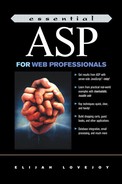Chapter 4. Editing Records
In This Chapter
Using a Web interface to edit records in a database
SQL insert, update, and delete statements
The ASP Session objectf
Password-protected Web pages with ASP
The Request.QueryString object
Regular expressions
Dynamically generated forms
The previous chapter covered a set of scripts that published information stored in a relational database to the Web. This chapter discusses a set of scripts that create a password-protected interface that can be used to edit the contents of that database.
By abstracting the contents of a Web site, storing these contents in a database, and creating an interface that is usable by nontechnical users, it becomes possible to create sites that can effectively publish large amounts of dynamic information.
Applied effectively, the approach outlined in this chapter goes a long way toward solving the biggest problem of Web design—maintaining the site after it's finished.
By abstracting the structure of a site (html templates, scripts, databases, servers, etc. …) from the information that is published within that structure (ideally, information stored in a database, but often, information that is trapped in a static HTML page), this chapter illustrates the extent to which all but the smallest Web sites have become collaborative projects.
Those of us concerned with technology need to coordinate with designers, strategists, marketers, copywriters, support people, and, of course, whoever is in charge of the purse strings. Increasingly, it's becoming important to set up a technical infrastructure that we can walk away from, leaving the other parties to manage the site. So you can dive into your next project and solve yet another puzzle.
This chapter illustrates one approach.
